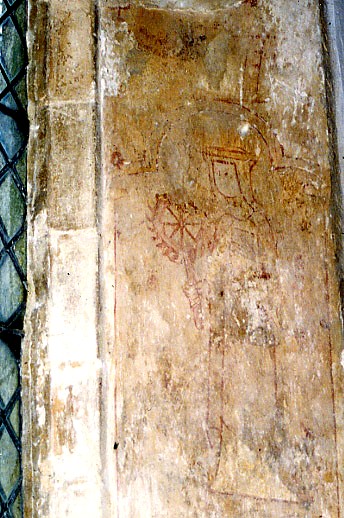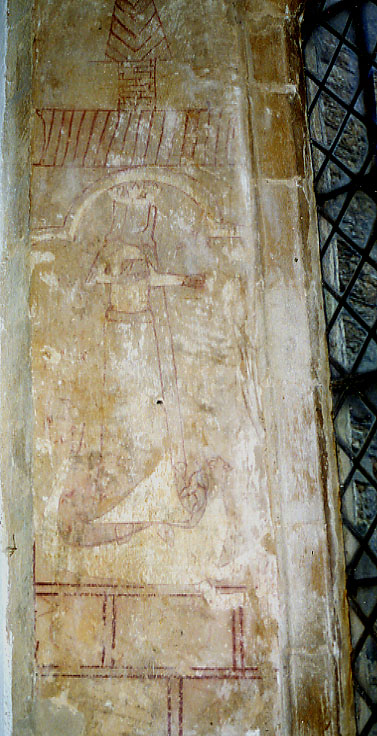Old Weston, Northamptonshire (†Ely) Early C.14
St Margaret of Antioch and St Catherine of Alexandria

Saints Catherine (right) and Margaret (below left) were the most popular of the female saints painted in the English medieval church and they are sometimes found together, as here. A Life of Catherine was first written in English in the 13th century, and this painting of her holding her attribute, a wheel, is not much later. She was the subject of the first English ‘Miracle’ or Saint’s play, written about 1100 by a monk called Gorran and performed in Dunstable, Bedfordshire. Later paintings of Catherine often show her with long loose hair and even bare-breasted, but here, as befits a pious virgin, she wears a sober headdress and a plain gown and cloak. Catherine (whose story seems to be entirely mythical) was scholarly as well as virginal, and accounts of her experiences may be based on the career of Hypatia of Alexandria, a renowned woman philosopher who died in 415 – at the hands of monks, many said.
Catherine is shown disputing with pagan philosophers in narrative scenes of her Life, her punishment for which was to be sentenced to breaking on the wheel by the Emperor Maxentius. This failed when the wheel broke (Divine Intervention is usually claimed, and painted) and Catherine was finally beheaded.

Here though she is simply shown as a standing figure, above some illusionistic brickwork, holding her hideously-spiked wheel by a kind of handle – details which now show in this new photograph. Also showing now is part of the arched (and possibly inscribed) tabernacle she stands in, and, curving upwards from the top of her head at the right, what might be a scroll identifying her.
St Margaret (left) has perhaps an even smaller claim than St Catherine to historical reality (Pope Gelasius in 494 declared her Legend apocryphal), but her cult in England may be even older, with a Life of her being written before the Norman Conquest Margaret, born a pagan, was an unwilling bride who refused the attentions of her would-be seducer, Olybrius, governor of Antioch. Thrown into prison as a result, she proclaimed herself a Christian and suffered various tortures. Finally she was swallowed by a dragon, which later burst open, allowing her to escape. She too was finally beheaded, but before this, perhaps inspired by the bursting of the dragon’s belly, she promised (as well as much else¹) that pregnant women who invoked her aid would ensure a safe childbirth. There is a story somewhere about a medieval English queen sending for the girdle that was one of Margaret’s relics to wear during her pregnancy.² She is probably leading the dragon by her girdle here – it is not visible, but the dragon is shown curving around the hem of Margaret’s gown, its head turned upwards (bottom right of figure), no doubt because Margaret is hoisting it up.
Both women hold books, and wear crowns – Margaret’s now showing well, Catherine’s very obscure – and the painted illusionistic brickwork, which shows best below St Margaret, (and is also below Catherine, but not shown here) is interesting. Visible behind Margaret is an archway in front of a building with a roof and a spire, and something similar may have been behind St Catherine. This might suggest a number of things about the place of, and beliefs about, the two saints in the English church, but I think the brickwork below, painted on an entirely different scale, may have had more to do with filling space and possibly even practising freehand horizontals and verticals. Apprentice-work, perhaps.
In churches with a number of subsidiary altars, the chances of finding one dedicated to St Catherine or St Margaret were high. A 15th century parishioner, presumably to be on the safe side about what Margaret actually wanted, (see note 1 below) gave ‘a taper in the form of St Margaret’ to Hoxne church, Suffolk. If this really did mean a candle shaped like St Margaret it must have been a curious sight as it burned.³
Website for St Swithun’s church, Old Weston
¹ Her promises were very comprehensive – e.g. that anyone writing or reading her history would receive a crown in heaven, that the dying who invoke her will be protected from devils, and that anyone dedicating churches or burning lights in them in her name will receive anything useful that they pray for. Quite all-embracing enough to account for her popularity.
²Was it Phillipa of Hainault, Edward III’s queen? It seems quite likely (especially given her husband’s fondness for relics).
³ Draper et. al., St Peter & St Paul, Hoxne, History & Guide [publication on sale in Hoxne church, 1990, Appendix 1-Medieval Wills from Norwich Record Office]